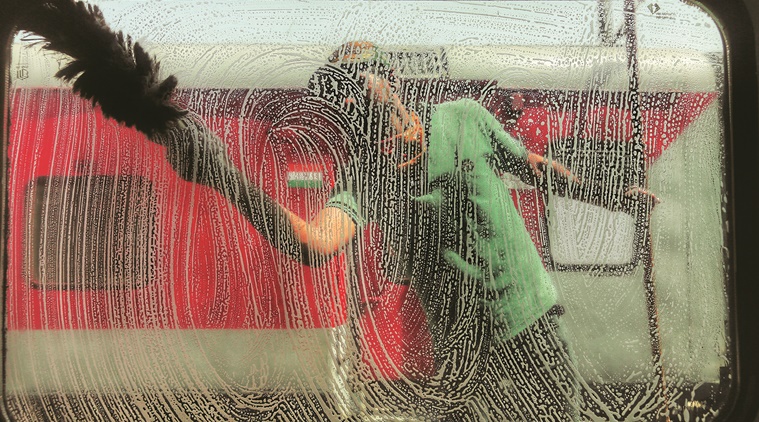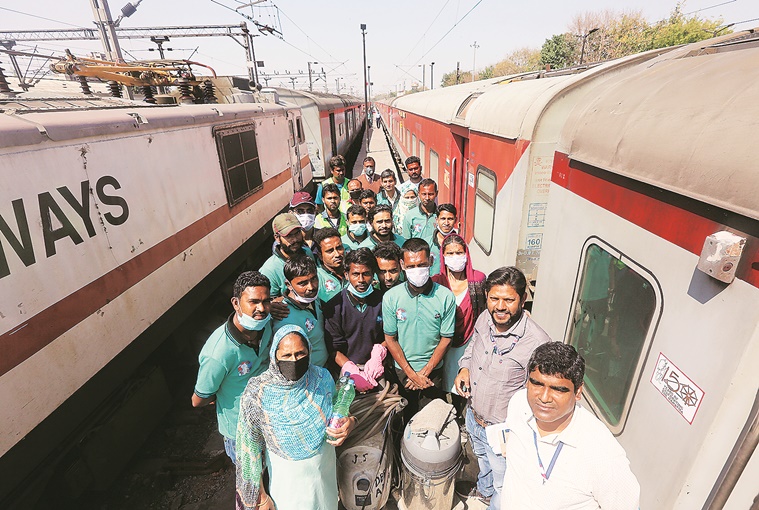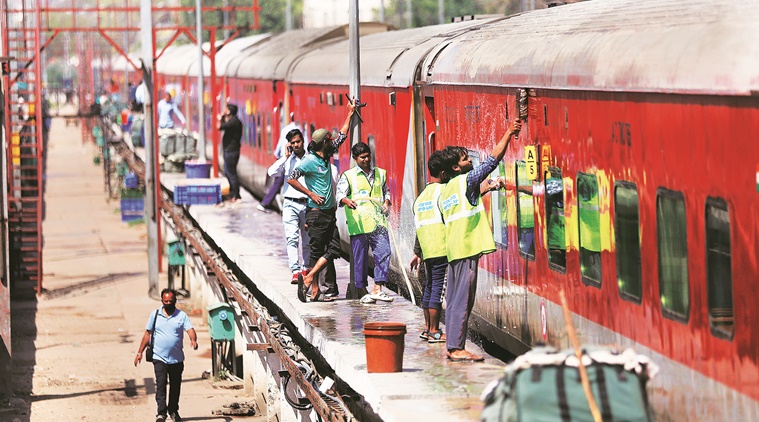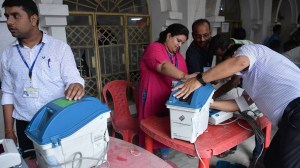- India
- International
Deep-cleaning a train
Amidst an unprecedented shutdown of trains today in response to the PM’s call for Janata Curfew to check the spread of COVID-19, The Indian Express on what it takes to corona-proof the Indian Railways and its 54,000 coaches: about 16,000 litres of cleaning agents and a trainful of resolve.
 Around 3.30 pm on Wednesday, the Delhi-Jammu Rajdhani Express gets a wash at New Delhi Railway Station. (Express Photo by Tashi Tobgyal)
Around 3.30 pm on Wednesday, the Delhi-Jammu Rajdhani Express gets a wash at New Delhi Railway Station. (Express Photo by Tashi Tobgyal)
Outside the red coach is an atypical smell — of soap and perfumed cleaning agents. Around 3.30 on a Wednesday afternoon, this and the other coaches of the Delhi-Jammu Rajdhani are getting an unhurried wash at the coach-washing lines at New Delhi railway station.
Around 20 men in masks, caps and gloves, and with brushes and jerry cans of chemicals and other cleaning agents, are doing what is by now a well-practised drill.
“It’s not just about cleaning or removing tough stains. It’s also about killing viruses and bacteria from each and every part. It has to be like a hospital’s operation theatre,” says one of the supervisors, dressed in a turquoise T-shirt and a fluorescent safety jacket. “Door handles are important… also the taps and the bathroom lock. It’s a 15-20-minute job per coach,” he says.
A tough journey
The train will leave for Jammu at 8.40 pm, some four hours from now. By the end of it, this Rajdhani would have got a wash lasting around six hours, certainly its most luxurious ever.
 With only four hours from departure, around 20 men and women have been pressed into service (Express Photo by Tashi Tobgyal)
With only four hours from departure, around 20 men and women have been pressed into service (Express Photo by Tashi Tobgyal)
This is a new routine for the workers and the trains, but then, these are extraordinary times. With the country in the midst of a COVID-19 pandemic — and with at least 14 of its passengers later testing positive for the virus till Saturday (March 21) — there are few certainties.

Every day, around 12,000 trains ferry 2.3 crore passengers across India. With every train journey an experience in communal living, from shared dabbas to shared toilets, ‘social distancing’ as a concept doesn’t sit too well. Which is what puts trains on the front lines of the coronavirus outbreak.
But the Indian Railways isn’t giving up. The national transporter has launched a string of measures to ensure that its trains don’t end up intensifying the spread of the virus. From washing down every coach to encouraging people to travel only if they absolutely must, to even announcing an unprecedented shutdown of its network in response to Prime Minister Narendra Modi’s call for a Janata Curfew to check the spread of the virus.
 Each train now undergoes a water bath after its every run. (Express Photo by Tashi Tobgyal)
Each train now undergoes a water bath after its every run. (Express Photo by Tashi Tobgyal)
On the morning of March 9, the Gatimaan Express from Delhi’s Hazrat Nizamuddin railway station started as usual on its journey to Jhansi via Agra. The train was nearly full. Everything went on as usual: the attendants handed newspapers and water bottles to the passengers and, minutes into the journey, came the food trolleys.
But unknown to all, among the passengers was a woman from Bengaluru whose husband had tested positive for COVID-19. She had flown down from Bengaluru to Delhi that morning, before taking the train to her parents’ home in Agra. A couple of days later, she too tested positive for coronavirus.
Soon, the phones began buzzing, all the way from the Railways to the health officials in Uttar Pradesh to the Union Ministry of Health and Family Welfare.
The coach the woman was in was taken out of service for thorough sanitisation. Details of all the passengers in that coach and on the train were dug out, and each of them was informed about possible exposure and where to contact if symptoms manifested.
The Indian Railway Catering and Tourism Corporation or IRCTC, which manages onboard services on the train, alerted its private vendor to check for symptoms among its staff who were on duty that day. As an added precaution, the train supervisor was asked to stay home for a couple of days and monitor himself.
It wasn’t over.
A couple of days later, on March 11, a 31-year-old, back from Italy, took the Bhubaneswar Rajdhani from the Capital and boarded an AC-III tier coach. By March 13, he became Odisha’s first COVID-19 positive patient.
 About 1,500 litres of water is used to wash a coach from outside and 300 litres more for the interiors. (Express Photo by Tashi Tobgyal)
About 1,500 litres of water is used to wash a coach from outside and 300 litres more for the interiors. (Express Photo by Tashi Tobgyal)
This time, too, the same protocol was set in motion. Both the incidents made officials in the Indian Railways realise just how easy it could be for someone to hide their exposure to COVID-19, board a train, and be a potential risk to hundreds of others entering its premises. The global pandemic had reached the doorsteps of the Indian Railways without giving it any lead time.
So the system wised up.
With no Standard Operating Procedure to fall back on, the Railway Board, in consultation with the Union Health Ministry, started formulating a plan.
Curtains in some 12,000 AC coaches were removed. Blankets, which are typically washed every two months, were taken out of service. The temperature of all AC coaches was increased so passengers didn’t feel the need for blankets. The idea was to take away vehicles of potential contamination to the extent possible.
Instructions were also issued to wash and disinfect coaches more than usual. Employees with mass contact jobs — ticket examiners, catering workers, reservation clerks, onboard housekeeping staff etc — were given instructions on wearing masks and sanitising themselves.
 Railways identified frequent contact surfaces on trains — door handles, seats, windows and suchlike, apart from the usual places like toilets and wash basins — and targeted those for frequent sanitisation even during the journey. (Express Photo by Tashi Tobgyal)
Railways identified frequent contact surfaces on trains — door handles, seats, windows and suchlike, apart from the usual places like toilets and wash basins — and targeted those for frequent sanitisation even during the journey. (Express Photo by Tashi Tobgyal)
“We formulated a protocol so that every division has a set-procedure of sanitisation to follow in this special situation,” said Arun Arora, Principal Chief Mechanical Engineer of Northern Railway.
Railways identified frequent contact surfaces on trains — door handles, seats, windows and suchlike, apart from the usual places like toilets and wash basins — and targeted those for frequent sanitisation even during the journey.
Handrails, railings, seats in waiting rooms and circulating areas in stations were targeted separately.
According to the earlier protocol, trains would be washed with water only after they returned to the base station following a to-and-fro run. But now, each train undergoes a water bath after its every run, along with a round of sanitisation with disinfection as prescribed by the Health Ministry and the Health Department of the Railways.
But how do you sanitise a network as vast as the Indian Railways? Turns out, it’s easier said than done.
The Railways has some 60,000 coaches of various kinds in circulation, around 6,000 of which are away for maintenance at any given time.
A one-time cleaning of the remaining 54,000 active coaches would require about 16,000 litres of cleaning agents, including almost 3,000 litres of disinfectants
for sanitisation.
Under the Railways’ revised cleaning plan, 50 ml of disinfectant is used in each coach (the quantity of which has been increased five times in view of the outbreak), 50 ml each of floor cleaning agents, toilet cleaning agents and berth rexine cleaner, 90 ml of a chemical for external surfaces and 800 ml of liquid soap for hand wash. In all, each coach uses up about 290 ml of cleaning agent/chemicals.
Besides, 1,500 litres of water is used to wash the coach from outside and 300 litres more for the interiors. In the few automatic coach washing plants that the Indian Railways has, the train gets a decent wash with an economical 600 litres.
Led by a supervisor, 17 men have six hours to turn a train, say, a Rajdhani, spick and span before it sets off from its home base.
Officials insist the cleaning routine is the same for all trains and that they now ensure no coach runs out of water and liquid soap, however long the journey.
Onboard 1,100 pairs of its trains, the Railways currently has housekeeping staff, who travel on the train and are supposed to carry out continuous cleaning and sanitisation. “You are now not likely to find a long-distance train, with a 14-15-hour journey time, that doesn’t have onboard cleaning staff. There is supposed to be one cleaner for every three coaches,” says a senior Railway official.
Then there are the stations.
Here, the contact pattern is haphazard and, unlike inside trains, unpredictable. Taking no chances, instructions have been issued to map out stations and identify each and every spot for cleaning.
At New Delhi railway station, for instance, which usually sees a footfall of five lakh a day, a team of 410 cleaners work in multiple shifts to sanitise the station area.
“Every four hours, the surfaces are cleaned. They include the lifts, its buttons, the escalators, the railing of the stairs and the like. The offices are cleaned, so are the benches, the waiting areas etc,” says Pankaj Kumar, the Railways’ Chief Health Inspector in New Delhi.
He says that in New Delhi alone, some 8 lifts and 10 escalators, apart from the offices and circulating areas, need to be fumigated and cleaned several times a day.
The catering staff have been asked to strictly adhere to guidelines issued by the Health Ministry and not deploy any staff with symptoms of flu. The Railways serves around 12 lakh meals a day.
In the initial days of the outbreak, the Railway Board had gauged that the system of thermal scanning in a huge system such as this would be impractical. But as days passed, it realised that there was no other way.
All the 68 Divisional Railway Managers (DRMs) were asked to purchase the thermal scanners using their existing powers of procurement in emergency situations.
On the Mumbai suburban network, desks have been set up at some of the busiest railway stations such as Churchgate and Bandra, where people can volunteer for thermal scanning.
The Thiruvananthapuram division of Southern Railway has taken the checks a step further. In collaboration with the state health department, railway personnel have been scanning passengers on board trains entering the state from Tamil Nadu.
“Officials typically board the train at a station, scan the passengers and get off at the next station. So far, there have been no positive cases but then how else do we track people who have symptoms but don’t disclose to us,” says S K Sinha, DRM, Thiruvananthapuram.
With the idea being to discourage non-essential travel, so far, the Railways has cancelled over 300 low-occupancy trains, translating to a notional financial loss of over Rs 400 crore. All luxury tourist trains have been cancelled too, leading to a loss of around Rs 25 crore.
The Railways is also advising people to travel only in case of emergencies. Official advisories to that effect are being sent out and SMS alerts carrying this message will soon be sent to those who book tickets.
There have been other measures as well — increasing prices of platform tickets to avoid overcrowding and withdrawal of concessions to senior citizens and others.
For the Indian Railways, keeping itself clean is just half the job done. For a system that runs 24×7 and, with its open platforms, is as porous as a sieve, it’s proving a multi-front battle.
Over two days this week, Railway authorities in Mumbai intercepted 23 cases of people with the Maharashtra government’s “home quarantine” stamps on their hands. These were people suspected to be carriers of coronavirus and who had been advised to stay at home, but were found on trains in violation of quarantine rules.
“After every such case (of people with the hand-stamps found travelling), we fumigated those coaches. With each case we are learning new things and learning fast,” says G V L Satya Kumar, Divisional Railway Manager of Mumbai Central.
These cases have forced the railway divisions to rely heavily on the presence of khaki on the premises.
All leaves of the Railway Protection Force (RPF) have been cancelled, leading to the entire 65,000-strong force to be on the ground. The RPF is enforcing crowd control and some sense of social distancing in queues.
“It’s all hands on the deck for us. Recently, we were informed that a person who had tested positive for the virus had travelled on a train from Bengaluru to Assam. We traced that person and handed him over to the health authorities,” said RPF Director General Arun Kumar. “The whole effort is to ensure that in these times, Railways as a mass transport is not misused.”
What makes it difficult is when one of their own flouts rules.
Recently, an Assistant Personnel Officer in Bengaluru had put up her son — who had returned from Germany via Spain with COVID-19 symptoms on March 13 — in the Railway Officers’ rest house there without informing anyone. While the officer has been placed under suspension, the rest house where her son stayed has been fumigated, disinfected and everyone who came in contact with the officer or were at the rest house were meticulously traced.
“It was a nightmare,” says an official in Bengaluru, while recalling the efforts at contact tracing and sanitisation.
In this multi-front war against the virus, the chain is only as strong as the weakest link. Railway officials insist that with every case, the organisation is improvising, reassessing and learning. And every train ride a new journey.
WHAT IT TAKES TO DISINFECT A TRAIN COACH
Disinfectant: 50 ml (usually 10 ml/coach. Now increased in view of COVID-19)
PVC floor cleaning agent: 50 ml
Toilet cleaning agent: 50 ml
Berth rexine cleaner: 50 ml
External surface: 90 ml
Total cleaning agents/chemicals per coach: 250 ml
PLUS,
800 ml liquid soap for hand wash
1,500 litres of water used to wash each coach from outside, 300 litres for interiors, including toilets
17 men led by a supervisor take six hours to clean a train before it sets off from its home base
Here’s a quick coronavirus guide for you to stay updated: Who all should be tested for Covid-19 and when? | How should you quarantine yourself? | How often (and how) should you clean your home? | What is the Janata Curfew announced by PM Modi? | Who are restricted from coming to India, and from when? | How long can the virus live on surfaces or in air around you? | Still more Coronavirus Q&A Explained news here
Apr 19: Latest News
- 01
- 02
- 03
- 04
- 05






































